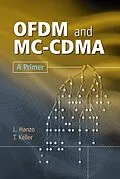Wireless communications has witnessed a tremendous growth during
the past decade and further spectacular enabling technology
advances are expected in an effort to render ubiquitous wireless
connectivity a reality.
Currently, a technical in-depth book on this subject is
unavailable, which has a similar detailed exposure of OFDM,
MIMO-OFDM and MC-CDMA. A further attraction of the joint treatment
of these topics is that it allows the reader to view their design
trade-offs in a comparative context.
Divided into three main parts:
Part I provides a detailed exposure of OFDM designed for
employment in various applications
Part II is another design alternative applicable in the
context of OFDM systems where the channel quality fluctuations
observed are averaged out with the aid of frequency-domain
spreading codes, which leads to the concept of MC-CDMA
Part III discusses how to employ multiple antennas at the
base station for the sake of supporting multiple users in the
uplink
By providing an all-encompassing self-contained treatment this
volume will appeal to a wide readership, as it is both an
easy-reading textbook and a high-level research monograph.
Autorentext
Lajos Hanzo received his degree in electronics in 1976 and his doctorate in 1983. During his 25-year career in telecommunications he has held various research and academic posts in Hungary, Germany and the UK. Since 1986 he has been with the Department of Electronics and Computer Science, University of Southampton, UK, where he holds the chair in telecommunications. He has co-authored eight books on mobile radio communications, published over 300 research papers, organised and chaired conference sessions, presented overview lectures and been awarded a number of distinctions. Currently he is managing an academic research team, working on a range of research projects in the field of wireless multimedia communications sponsored by industry, the Engineering and Physical Sciences Research Council UK, the European IST Programme and the Mobile Virtual Centre of Excellence, UK. He is an enthusiastic supporter of industrial and academic liaison and he offers a range of industrial courses. He is also an IEEE Distinguished Lecturer. For further information on research in progress and associated publications please refer to www-mobile.ecs.soton.ac.uk.
Thomas Keller is a professor in the Institute of Business Information Technology at the ZHAW School of Management and Law in Zurich.
Klappentext
This concise volume provides a widely accessible introduction to OFDM and MC-CDMA. Based on the authors' experience in researching OFDM in the context of various applications, it systematically converts the lessons of Shannon's information theory into practical wireless system design examples. Comprehensive coverage of OFDM, MIMO-OFDM and MC-CDMA is presented, incorporating radically new research-oriented principles. A further strength of this primer is that it considers the ambitious aim of achieving near-maximum-likelihood multi-user MIMO-OFDM performance at a modest complexity, proposing an advanced extension of the Complex Sphere Detector (CSD). This technique allows the system to support a higher number of OFDM/MC-CDMA users than the number of antennas even in the case of high-throughput QAM schemes.
- The design and performance of OFDM modems are highlighted, covering both Gaussian and wideband fading channels, frequency domain synchronization as well as adaptive single- and multi-user OFDM
- Offers a comparative study of OFDM and MC-CDMA, discussing spreading sequences, adaptive modulation and the attainable performance in synchronous environments
- Contains an advanced section on genetic algorithm aided joint multi-user channel estimation techniques for multi-user SDMA-OFDM
- Introduces an avant-garde design principle, which aims for directly minimizing the bit error ratio (BER) at the output of the multi-user OFDM system
As an introductory treatment of the complex subject of OFDM, this primer text will be attractive to a wide readership, including postgraduate students, systems and development engineers, as well as communications managers and practitioner.
Zusammenfassung
Wireless communications has witnessed a tremendous growth during the past decade and further spectacular enabling technology advances are expected in an effort to render ubiquitous wireless connectivity a reality.
Currently, a technical in-depth book on this subject is unavailable, which has a similar detailed exposure of OFDM, MIMO-OFDM and MC-CDMA. A further attraction of the joint treatment of these topics is that it allows the reader to view their design trade-offs in a comparative context.
Divided into three main parts:
Part I provides a detailed exposure of OFDM designed for employment in various applications
Part II is another design alternative applicable in the context of OFDM systems where the channel quality fluctuations observed are averaged out with the aid of frequency-domain spreading codes, which leads to the concept of MC-CDMA
Part III discusses how to employ multiple antennas at the base station for the sake of supporting multiple users in the uplink
By providing an all-encompassing self-contained treatment this volume will appeal to a wide readership, as it is both an easy-reading textbook and a high-level research monograph.
Inhalt
About the Authors.
Other Wiley and IEEE Press Books on Related Topics.
Acknowledgements.
1. Introduction.
2. Introduction to Orthogonal Frequency Division Multiplexing.
3. OFDM Transmission over Gaussian Channels
4. OFDM Transmission over Wideband Channels.
5. OFDM Time and Frequency Domain Synchronisation.
6. Adaptive Single- and Multi-user OFDM Techniques.
II. OFDM versus MC-CDMA Systems.
7. OFDM versus MC-CDMA.
8. Basic Spreading Sequences.
9. MC-CDMA Performance in Synchronous Environments.
III. Advanced Topics: Multi-User OFDM Systems.
10 Maximum-Likelihood Enhanced Sphere Decoding of MIMO-OFDM.
11. Genetic Algorithm Aided Joint Channel Estimation and MUD for SDMA OFDM.
12. Multi-User OFDM Employing Genetic Algorithm Aided Minimum Bit Error RateMulti-User Detection.
13. Conclusion and Further Research Problems.
Glossary.
Bibliography.
Subject Index.
Author Index.
